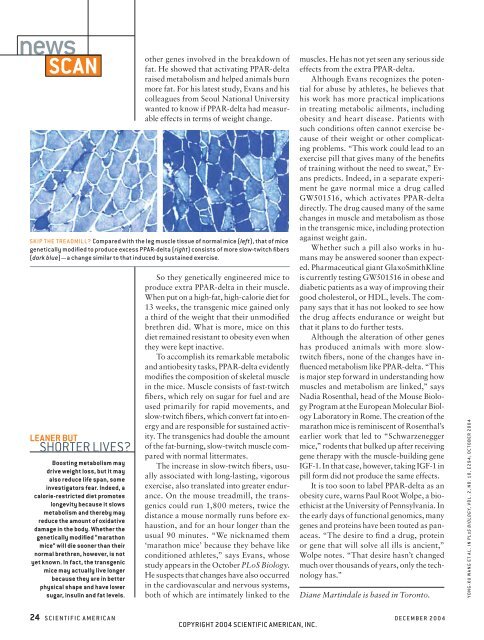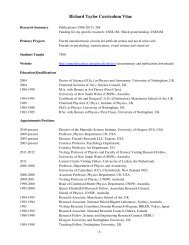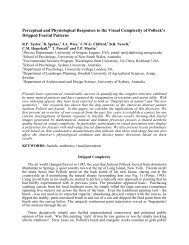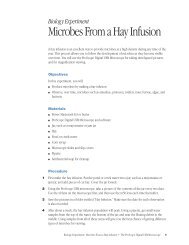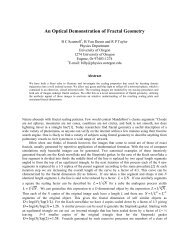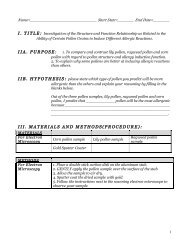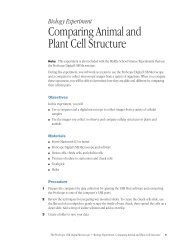December 2004 - Materials Science Institute - University of Oregon
December 2004 - Materials Science Institute - University of Oregon
December 2004 - Materials Science Institute - University of Oregon
Create successful ePaper yourself
Turn your PDF publications into a flip-book with our unique Google optimized e-Paper software.
news other genes involved in the breakdown <strong>of</strong><br />
SCAN<br />
fat. He showed that activating PPAR-delta<br />
raised metabolism and helped animals burn<br />
more fat. For his latest study, Evans and his<br />
colleagues from Seoul National <strong>University</strong><br />
wanted to know if PPAR-delta had measurable<br />
effects in terms <strong>of</strong> weight change.<br />
SKIP THE TREADMILL? Compared with the leg muscle tissue <strong>of</strong> normal mice (left), that <strong>of</strong> mice<br />
genetically modifi ed to produce excess PPAR-delta (right) consists <strong>of</strong> more slow-twitch fi bers<br />
(dark blue)—a change similar to that induced by sustained exercise.<br />
LEANER BUT<br />
SHORTER LIVES?<br />
Boosting metabolism may<br />
drive weight loss, but it may<br />
also reduce life span, some<br />
investigators fear. Indeed, a<br />
calorie-restricted diet promotes<br />
longevity because it slows<br />
metabolism and thereby may<br />
reduce the amount <strong>of</strong> oxidative<br />
damage in the body. Whether the<br />
genetically modifi ed “marathon<br />
mice” will die sooner than their<br />
normal brethren, however, is not<br />
yet known. In fact, the transgenic<br />
mice may actually live longer<br />
because they are in better<br />
physical shape and have lower<br />
sugar, insulin and fat levels.<br />
So they genetically engineered mice to<br />
produce extra PPAR-delta in their muscle.<br />
When put on a high-fat, high-calorie diet for<br />
13 weeks, the transgenic mice gained only<br />
a third <strong>of</strong> the weight that their unmodifi ed<br />
brethren did. What is more, mice on this<br />
diet remained resistant to obesity even when<br />
they were kept inactive.<br />
To accomplish its remarkable metabolic<br />
and antiobesity tasks, PPAR-delta evidently<br />
modifi es the composition <strong>of</strong> skeletal muscle<br />
in the mice. Muscle consists <strong>of</strong> fast-twitch<br />
fi bers, which rely on sugar for fuel and are<br />
used primarily for rapid movements, and<br />
slow-twitch fi bers, which convert fat into energy<br />
and are responsible for sustained activity.<br />
The transgenics had double the amount<br />
<strong>of</strong> the fat-burning, slow-twitch muscle compared<br />
with normal littermates.<br />
The increase in slow-twitch fi bers, usually<br />
associated with long-lasting, vigorous<br />
exercise, also translated into greater endurance.<br />
On the mouse treadmill, the transgenics<br />
could run 1,800 meters, twice the<br />
distance a mouse normally runs before exhaustion,<br />
and for an hour longer than the<br />
usual 90 minutes. “We nicknamed them<br />
‘marathon mice’ because they behave like<br />
conditioned athletes,” says Evans, whose<br />
study appears in the October PLoS Biology.<br />
He suspects that changes have also occurred<br />
in the cardiovascular and nervous systems,<br />
both <strong>of</strong> which are intimately linked to the<br />
muscles. He has not yet seen any serious side<br />
effects from the extra PPAR-delta.<br />
Although Evans recognizes the potential<br />
for abuse by athletes, he believes that<br />
his work has more practical implications<br />
in treating metabolic ailments, including<br />
obesity and heart disease. Patients with<br />
such conditions <strong>of</strong>ten cannot exercise because<br />
<strong>of</strong> their weight or other complicating<br />
problems. “This work could lead to an<br />
exercise pill that gives many <strong>of</strong> the benefi ts<br />
<strong>of</strong> training without the need to sweat,” Evans<br />
predicts. Indeed, in a separate experiment<br />
he gave normal mice a drug called<br />
GW501516, which activates PPAR-delta<br />
directly. The drug caused many <strong>of</strong> the same<br />
changes in muscle and metabolism as those<br />
in the transgenic mice, including protection<br />
against weight gain.<br />
Whether such a pill also works in humans<br />
may be answered sooner than expected.<br />
Pharmaceutical giant GlaxoSmithKline<br />
is currently testing GW501516 in obese and<br />
diabetic patients as a way <strong>of</strong> improving their<br />
good cholesterol, or HDL, levels. The company<br />
says that it has not looked to see how<br />
the drug affects endurance or weight but<br />
that it plans to do further tests.<br />
Although the alteration <strong>of</strong> other genes<br />
has produced animals with more slowtwitch<br />
fi bers, none <strong>of</strong> the changes have infl<br />
uenced metabolism like PPAR-delta. “This<br />
is major step forward in understanding how<br />
muscles and metabolism are linked,” says<br />
Nadia Rosenthal, head <strong>of</strong> the Mouse Biology<br />
Program at the European Molecular Biology<br />
Laboratory in Rome. The creation <strong>of</strong> the<br />
marathon mice is reminiscent <strong>of</strong> Rosenthal’s<br />
earlier work that led to “Schwarzenegger<br />
mice,” rodents that bulked up after receiving<br />
gene therapy with the muscle-building gene<br />
IGF-1. In that case, however, taking IGF-1 in<br />
pill form did not produce the same effects.<br />
It is too soon to label PPAR-delta as an<br />
obesity cure, warns Paul Root Wolpe, a bioethicist<br />
at the <strong>University</strong> <strong>of</strong> Pennsylvania. In<br />
the early days <strong>of</strong> functional genomics, many<br />
genes and proteins have been touted as panaceas.<br />
“The desire to fi nd a drug, protein<br />
or gene that will solve all ills is ancient,”<br />
Wolpe notes. “That desire hasn’t changed<br />
much over thousands <strong>of</strong> years, only the technology<br />
has.”<br />
Diane Martindale is based in Toronto.<br />
24 SCIENTIFIC AMERICAN DECEMBER <strong>2004</strong><br />
COPYRIGHT <strong>2004</strong> SCIENTIFIC AMERICAN, INC.<br />
YONG-XU WANG ET AL. IN PLO S BIOLOGY, VOL. 2, NO. 10, E294; OCTOBER <strong>2004</strong>


